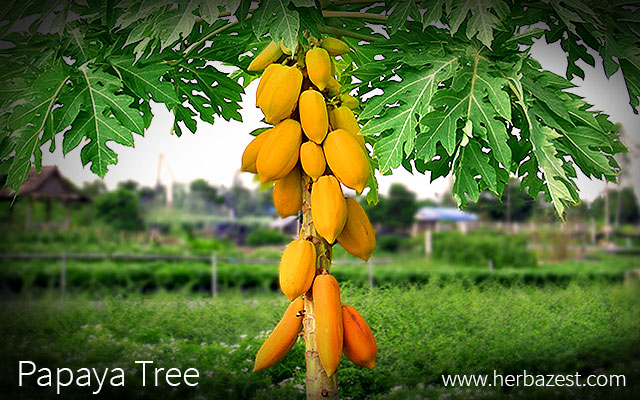A little known fact about the papaya tree is that it really isn't a tree at all. Producing none of the necessary woody tissue to be defined as a tree, papaya is best described as an herbaceous crop with a tough, thickened stem. In common, everyday speech, however, the term tree has been adapted as an acceptable way of denoting the papaya plant.
Papaya Tree Information
Growing up to 30 feet (9 m) tall, the papaya fruit tree is a large herb capped by a canopy of dark green, deeply-lobed leaves arranged on long, horizontally-stretching petioles. The papaya tree flowers can be white or yellow, and bloom all year long in clusters just below the leaves, some of them giving birth to round, oblong, or pear-shaped fruits. Because the plant does not tolerate frost and cold temperatures, tropical and subtropical regions are the best places to cultivate papaya trees.
The succulent stem of the papaya tree is green or purplish, and it is responsible for supplying all plant extremities with nourishing minerals. Hollow and with a coarse outer surface caused by leaf scarring, it grows to around 12 - 16 inches (30 - 40 cm) thick at its base, but makes for lousy timber.
For propagation purposes, the Carica papaya tree can produce female, hermaphroditic, or male flowers. Given the polygamous nature of this plant, in order to ensure a successful yield for commercial purposes, it is very important to select papaya seeds of the desired type. However, it is impossible to determine the sex of the plant prior to flowering.
WHILE MALE BLOSSOMS CANNOT BEAR FRUIT, IN RARE INSTANCES, SEX CHANGES HAVE BEEN NOTED IN MALE PAPAYA TREES, WHICH HAVE TURNED HERMAPHRODITIC IN HIGH HEAT.
Though not an exact science, the sex of a future papaya tree can be predicted by knowing the source of pollen and the kind of flower the fruit came from. This is why hand pollination is crucial in order to obtain the desired combination of flower types.
Papaya Tree Uses
With sweet and succulent flesh, papaya fruits have become a worldwide sensation for their use in freshly-pressed juices, tropical fruit salads, dried candies, jams, and preserves. The sap of an unripe, green papaya can also be used to tenderize meat and clarifying beer.
In the cosmetic and pharmaceutical industries, papaya tree uses focus primarily on the extraction of the enzyme papain. Present in the papaya leaf, stem, and immature fruit, it has traditionally been used to remove freckles, quiet stomach troubles, and reduce inflammation from tonsillitis. Today, scientific research has already begun to validate papain's anti-inflammatory, cytoprotective, and antibacterial properties.
PAPAIN AND OTHER DERIVATIVES OF THE PAPAYA TREE HAVE EXHIBITED EFFICACY IN THE TREATMENT OF MANY HUMAN ILLNESSES, INCLUDING SKIN PROBLEMS, HIGH BLOOD PRESSURE, AND INFLAMMATORY BOWEL DISEASE.
Other important parts of the papaya tree include its thick stem, which is used for making rope; its leaves, which are traditionally smoked to relieve respiratory illness; and the plant itself, which holds ornamental value even after the fruits have been harvested.
Despite being vaguely familiar with its delicious tropical fruits, many consumers fail to realize the extent of the papaya tree's usefulness. Of significant culinary, cosmetic, medicinal, and industrial importance, the papaya tree is a fountain of untapped potential.
Sources
- Breeding Plantation Tree Crops: Tropical Species, pp. 121 - 127
- Missouri Botanical Garden, Carica papaya
- National Gardening Association, Determining the Sex of a Papaya Tree
- Organisation for Economic Co-operation and Development (OECD), Safety Assessment of Transgenic Organisms
- Papaya the Medicine Tree, pp. 11 - 12
- Purdue University, Papaya, Carica papaya | Carica papaya L.
- The Hope, Hype, and Reality of Genetic Engineering, pp. 4 - 5
- University of Arizona, The Master Gardener Journal, Papaya: A Tantalizing Taste of the Tropics
- University of Florida, Papaya Growing in the Florida Home Landscape




